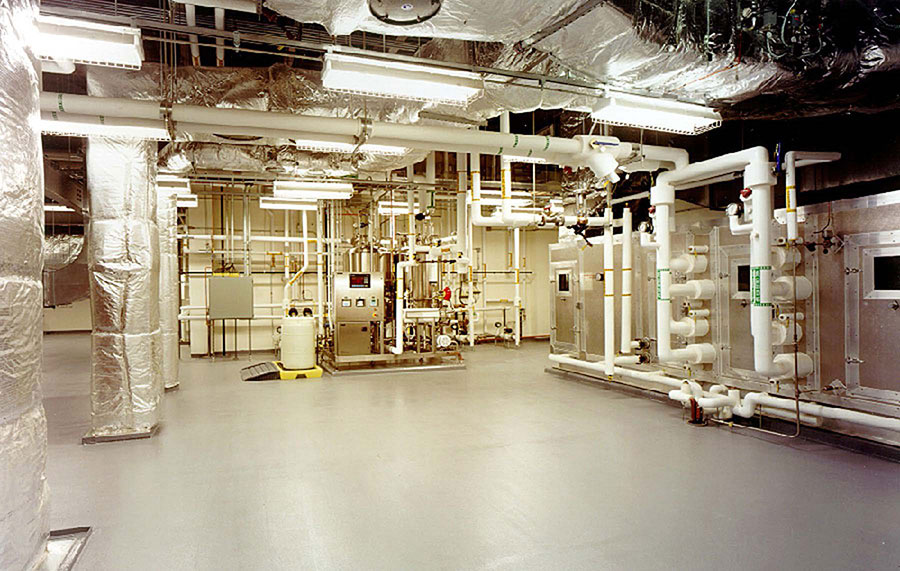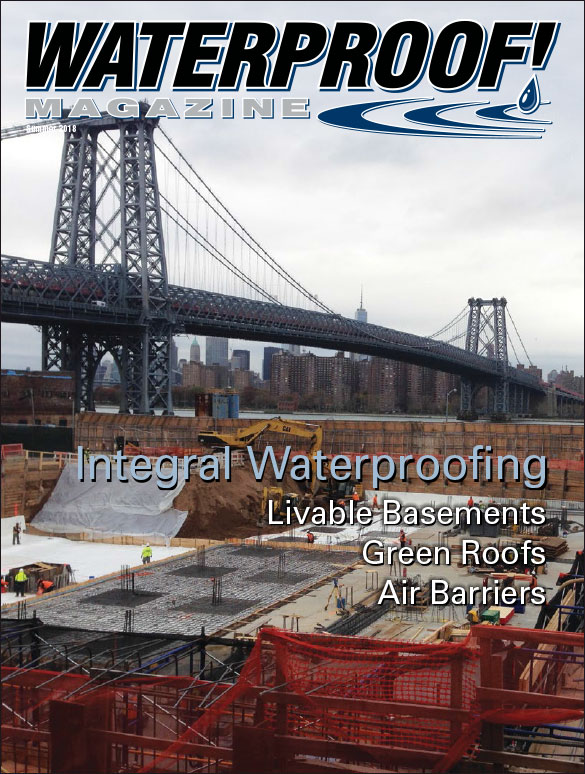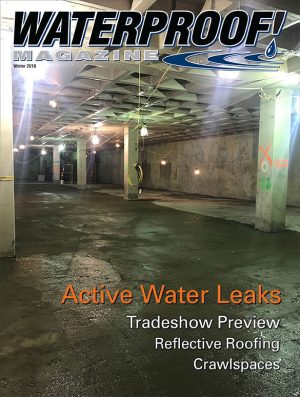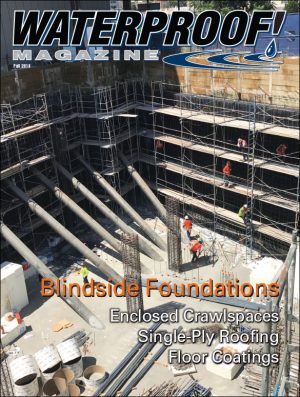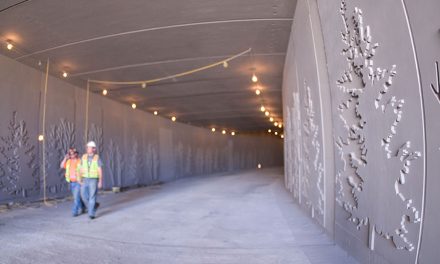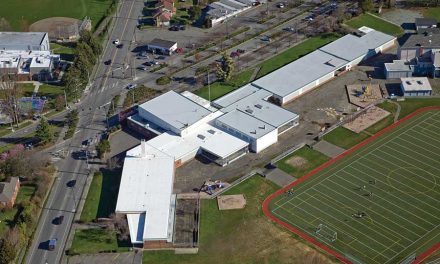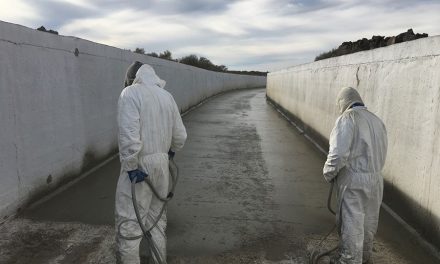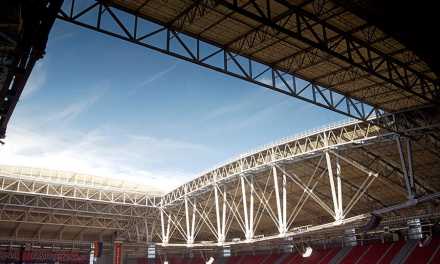Waterproofing typically deals with vertical below-grade surfaces, but horizontal slabs at or below grade require attention as well.
With new construction in vulnerable areas, underslab barriers can solve the problem (See story in the Spring 2012 issue). However, most existing structures—residential, commercial, and industrial—have been built without protection.
While uncracked concrete will typically repel liquids, water vapor can still penetrate it quite easily. Additionally, nearly all concrete slabs experience some degree of cracking.
An unsealed basement floor will sometimes allow gallons of water to pass through it daily. Thousands of homeowners have moved their belongings into an unfinished basement, only to discover that the supposedly dry storage room isn’t so dry after all. Commercial buildings, too, frequently suffer from uncontrolled moisture wicking up through the slab.
This moisture can destroy flooring and promote mold and odors.
A range of floor coatings and remedial drainage solutions have been developed to prevent these unpleasant and costly experiences.
“Waterproofing floor technology can greatly augment a facility’s flooring investment, and proper installation by a team of manufacturer-approved professionals can make all the difference,” says James Gildea, U.S. marketing manager for Sika Corporation’s flooring division.
Drain First
The first step to ensuring a dry slab is to relieve the hydrostatic pressure and get the water away from the bottom of the foundation.
Joseph Boccia, owner of Boccia, Inc., explains that unless water issues are resolved, “coatings on the negative side of the structure are typically pushed off the surface they are applied on. Tenaciously adhered coatings will sometimes take a portion of the floor or wall with them, leaving a spalled condition that could create a structural concern.”


Without adequate drainage, hydrostatic pressure will lift off any coating applied to the upper surface of damp concrete
Drying out a slab requires installing an interior drainage system around the perimeter of the floor. Simply injecting the cracks—as is common on basement walls—will not solve the problem. Matthew Stock, president of U.S. Waterproofing, explains, “The only way to solve the seepage problem is to relieve the hydrostatic pressure and the only way to do so is to install interior drain tile. If a basement waterproofing contractor were to inject a crack in a basement floor, the urethane would indeed prevent further seepage but would do nothing to relieve the hydrostatic pressure. As a result, the water that had been seeping upward through the floor cracks would remain under pressure and just find another way into your basement, most likely through the cove joint. The same would apply for epoxy injection.”
With drain tile in place on the inside of foundation footings, the ground water has somewhere to go: into the drain tile which carries it to a sump pump.
Both Stock and Boccia market interior drain tiles for this type of application.
Coating Options
Most companies that market floor coatings offer a range of products with different formulations and chemistries to meet the needs of the job.
Sika, for instance, offers three different product lines: In addition to the polyurethane-based PurCem, they sell SikaFloor, which is an epoxy-based system that works well even if the substrate has a high moisture content. Gildea says, “Epoxy cement formulations are usually preferred for moisture mitigation in the food and beverage industry.” Finally, SikaFloor Merflex combines the crack-bridging and waterproofing benefits of a flexible membrane with the seamless wear protection of an epoxy or urethane top coat.
Gildea adds, “Our reps will take the time to look at the causes of the issues, the use of the room, even down to the cleaning regimen, and put together a unique solution based on those needs and requirements.”
Rhino Linings Industrial is another floor coating provider with a range of epoxy-, polyurethane- and polyaspartic-based floor coatings. They also market polymer cement overlays for decorative, repair and resurfacing. Amber Marks, global marketing manager for the company, says, “Our product formulations vary from quick-set coatings to polymer overlays but they all can stand up to wear and tear from heavy traffic. Depending on the product selection, our flooring products can be applied by hand, high pressure spray, brush, roller, squeegee or trowel.”
Food-Grade Solutions
Floor coatings are frequently needed in commercial food preparation facilities, where sanitation and safety are top priorities.
Léf Farms in Loudon, NH grows lettuce for the Northeastern U.S., with the goal of providing New Englanders with fresh produce within 24 hours of harvest, instead of greens that have spent days in a truck being shipped across country.
When they planned a new hydroponic greenhouse with fully automated processing, they needed a solution to protect the floors and eliminate the safety hazard that wet slippery concrete can create. Additionally, they were committed to using the highest quality materials and exceed all food safety regulations, including the Food Safety Modernization Act (FSMA). FSMA went into effect in 2014, and represents the biggest overhaul of food safety regulations since 1938. (The 2009 FDA Food Code only specifies that food establishments must have floors that are “smooth, durable, and easily cleanable.”)

At this New Hampshire lettuce packing plant, a polyurethane-based coating protects the floor from moisture, reduces the risk of slipping, and meets FSMA standards.
They chose a polyurethane floor coating from Sika dubbed PurCem, which protected the concrete and also provides a slip resistant texture.
“Our goal was to create a floor that was crack-resistant and would not allow any contaminants to exist,” explained Russ Elkins, facilities manager at Pleasant View Gardens, Inc., which oversees the greenhouse. “We also wanted a floor that had a long lifespan, and this particular floor exceeded our expectations.”
Wells Restoration, a veteran SikaFloor installer in the region, followed up on the lead. He met with Elkins, explained the options, and even installed some samples on site. That sealed the deal. Scott Wells, president of the company, points out, “This also helped us gain a better understanding of what the customer needed.”
Elkins gave them free access to the facility for the installation, “without another soul in our way,” Wells says. The installation took place in July 2016, and they have not had any issues since.
“They did it the right way,” Well says.
Polyurethane floor coatings have also been used successfully to repair, seal and waterproof restaurant floors.
When a Japanese restaurant under renovation required a central drain system in the kitchen and waterproof coating for the kitchen floor to prevent water damage and ensure that the new system would operate efficiently, they chose a polyurethane system from Rhino Linings Industrial.
This was a working restaurant where multiple renovations were going on simultaneously, and only two days were allocated for the job before the kitchen needed to be returned to service.
The contractor recommended a fast-setting polyurea coating, Rhino Extreme 11-50. It’s a spray-applied, fast-set polyurea with excellent tensile strength, elongation and tear abrasion resistance, perfect for standing up to the daily wear and tear of a commercial kitchen.
The concrete slab was prepared with water blasting and cleaning, primed with a roller and brush at 15 mils, and then the 11-50 was spray-applied at approximately 80 mils. The 516 sq. ft. area was completed in just two days.
Food Processing

When moisture problems originated inside the facility, Smith carefully sealed off the work area, then installed a floor drain system to direct the water away from the structure.
Sometimes, shutting down the facility for even a few days isn’t an option. Brandon Smith, owner of Smith’s Waterproofing LLC, in Almont, Mich., was asked to help a pickle factory deal with the internal moisture and humidity problems they were struggling with, but the bottling plant operated 24 hours a day and the owner was extremely reluctant to curtail operations. The source of the moisture was easily identified. “Just the process of bottling and processing the food causes a huge amount of steam in the building,” Smith says. “That moisture was causing problems to the structure. However, the plant operates 24 hours a day, so there wasn’t much time between processing sessions to deal with the water.”
Smith helped the plant develop a humidity control and drainage system to deal with the water issues and constant humidity.
“It wasn’t much different than any other interior remedial waterproofing job,” Smith says. “The same principles apply just on a larger scale.”
Smith reports that the most interesting and difficult part of this project was working in an operating 24-hour facility. To eliminate the possibility of contamination, work areas were completely sealed off, and the job was completed as quickly as possible. Smith says keeping the area completely contained while they worked was the hardest part of the project but also rewarding.
This is not an isolated case. Jason Weinstein of Budget Dry Waterproofing, Inc. in Guilford, Conn., was asked to visit an East Coast bakery and identify the root cause of their moisture issues and install a permanent solution. In this case, the water problems were serious enough that the prefabricated metal building was rusting.
He was surprised to discover that, again, the source of the moisture was inside the building, originating from washing out the mixers and bakery machinery several times daily. “It isn’t always an external source of water affecting the building,” Weinstein says. “Sometimes it is a water issue from an inside source.”
Weinstein designed an interior drainage system to divert the water outside and then waterproofed the floor. “This was not from rainwater coming in but from water sources on the inside,” Weinstein confirms. “If you can’t stop the water from coming in, the next best thing is to control where the water goes when it does come in.”
The custom drainage system drained the problem areas and tied into a perimeter drain that carried the water outside to the drain field.
Overall, Smith and Weinstein both say the principles of keeping slabs dry are fairly simple. “Whether it is an internal or external water source, the same properties of water still apply,” Weinstein says. “Remedial waterproofing is about controlling and managing the water.”
Summer 2018 Back Issue
$4.95
Livable Basements
AVAILABLE AS DIGITAL DOWNLOAD ONLY
Description
Description
Additional Info
Additional information
| Magazine Format | Digital Download Magazine, Print Mailed Magazine |
|---|

